ADONE ( 1969-1993 )
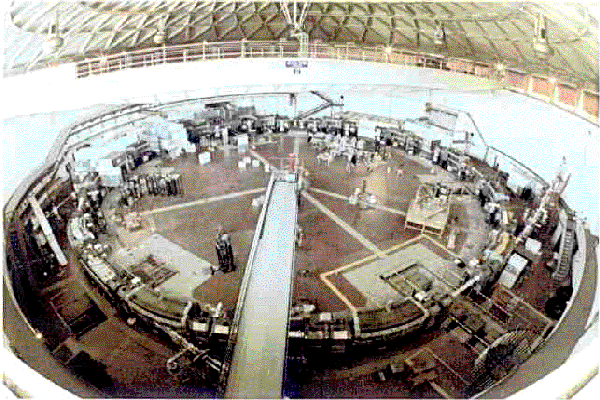
Following the success of ADA, it was decided
to build in the Frascati
National Laboratory a storage ring of the same kind, with larger
top energy and intensity, with the aim of exploring the new energy range
in subnuclear physics opened by the possibility of observing particle-antiparticle
interactions with center of mass at rest.
The construction of the new machine began in 1963: a 350 MeV Linac,
built by Varian (USA), was used as an electron and positron injector. This
machine was capable of delivering high current (~100 mA) electron pulses
of 4 µ s length at a frequency ranging from 1 to 250 pulses per second:
in order to produce a positron beam a tungsten target could be inserted
in the beam line to stop the electron beam after the first four high current
accelerating sections (~4 A at an energy between 60 and 80 MeV): positrons
were created by bremsstrahlung and pair production in the target, with
an efficiency of ~0.1%.
The 1.5 GeV per beam, 105 m long storage ring is divided into 12 equal
cells, each one consisting of a bending magnet with a quadrupole doublet
and a half straight section on each side. The free space in the straights
available for the experiments was ~2.5 m. Four radiofrequency cavities,
running on the third harmonic of the revolution period (350 ns) delivered
a total accelerating voltage of 120 KV. An adiabatic closed orbit deformation
obtained with by a couple of pulsed coils inside the vacuum vessel allowed
multiturn injection of the long pulses coming from the Linac through a
short transfer line. Three electron bunches crossed the corresponding positron
ones in 6 out of the 12 available straight sections. Two of them were occupied
by the R.F. cavities, the other 4 could host the experimental setups which
were able to observe the electron-positron interactions at the same time.
The 6 non crossing sections were used for injection and diagnostic equipment.
The luminosity of the collider was measured by detecting the rate of electron-positron
small angle scattering, single and double beam-beam bremsstrahlung.
The first electron beam was stored at the end of 1967. The first positron
injections immediately put in evidence a new kind of instability, the "head-tail"
effect, which inhibited the storage of the required positron intensity.
In parallel to the theoretical explanation of this effect a feed-back system,
picking up the position of the beam and providing proper action on the
beam by means of variable electromagnetic fields, was implemented on the
ring, allowing the storage of the design electron and positron current
and the achievement of the design luminosity of 3x10^29 cm^-2 s^-1 per
crossing.
The first generation experiments, and successively
the second generation ones, explored the physics
of electron-positron collisions up to 3.0 GeV in the center of mass, from
1969 to 1978. After that time, the storage ring was deeply modified, in
order to be used with the electron beam as a source
of synchrotron radiation (PULS,
PWA) and of monochromatic, intermediate energy gamma-ray beams for
nuclear physics (LADON) obtained by colliding
the electron beam with a laser. The main changes in the storage ring structure
were a new single radiofrequency cavity, running at 51 MHz on the 18-th
harmonic of the revolution period and the replacement of the vacuum vessel
with the introduction of a distributed system of detection and correction
of the beam position, in order to accurately control the source points
for the beam lines. Still for nuclear physics experiments, an internal
gas target (JET TARGET) was realised in
1988: it consisted of an Argon (and successively other gases) beam shot
at the velocity of sound at right angle on the electron beam, producing
an intense gamma-ray beam. Finally, in 1991, electron-positron operation
was resumed to study neutron-antineutron production and measure the nucleon
form factors (FENICE
experiment). The beam from the Linac was also used directly for nuclear
physics experiment (LEALE).
ADONE was shut down on April 26, 1993 to allow the construction of a
new low energy, high luminosity collider, DAFNE,
inside its building: Prof. Giorgio Salvini, the first Director of the Frascati
National Laboratory switched off the last stored beam, after 24
years of operation, during which ~22000 hours of colliding beam and ~5300
hours of single beams had been delivered to the experiments.
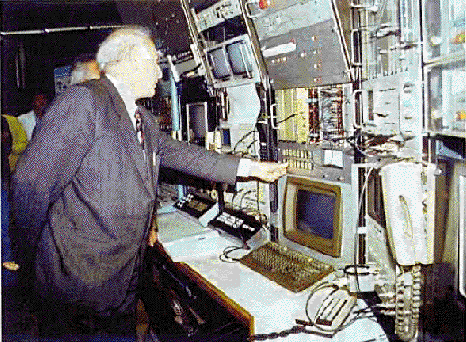
FIRST GENERATION EXPERIMENTS AT ADONE
-
 The Gamma-Gamma Detector
The Gamma-Gamma Detector
-
 The Mu-Pion Detector
The Mu-Pion Detector
-
 The Boson Detector
The Boson Detector
-
 The BCF Detector
The BCF Detector
-
Click on icon to get the picture (~ 200 Kb)
The experimental activity on ADONE with colliding beams began in 1969 with
four experiments, run by groups from several italian institutions, with
the aim of studying many aspects of the electron-positron interactions,
such as the test of quantum electrodynamics predictions, the search for
new vector mesons and leptons heavier than the electron and the muon, the
measurement of the production rates of muon pairs and hadrons.
The "Gamma-Gamma" Experiment (with researchers
from Frascati and Rome) had, as a principal goal, the detailed study of
reactions with neutral particles in the final state. Its experimental setup
included scintillator counters following lead plates for the conversion
of the photons and spark chambers to show the produced showers.
The "Mu-Pion" Experiment (Frascati, Rome,
Padua) was mainly dedicated to production of muon, pion and K meson pairs
from the electron-positron annihilation. The setup consisted of scintillation
counters, spark chambers seen from above by means of characteristic long
mirrors and water Cerenkov counters to separate the pions from K mesons.
Large iron shields interleaved to the spark chambers allowed muon identification.
Flash tube chambers were also part of the detection system.
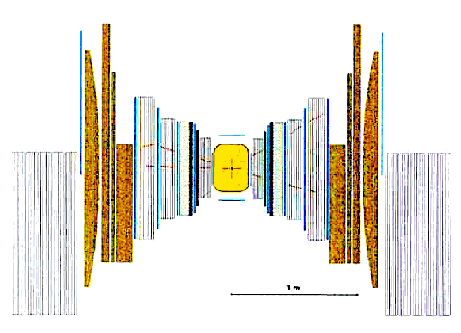 A schematic representation of an event with 5 hadrons in the
final state observed by the "Mu-Pion" experiment. Scintillation counters
appear in blue colour, the iron absorbers are brown, and the grey ones
are lead. Particle tracks in spark chambers are shown in red.
A schematic representation of an event with 5 hadrons in the
final state observed by the "Mu-Pion" experiment. Scintillation counters
appear in blue colour, the iron absorbers are brown, and the grey ones
are lead. Particle tracks in spark chambers are shown in red.
The "Boson" Experiment , run by physicists
from Frascati, Naples, Pavia and Rome, employed a very compact setup, made
of scintillators and wire magnetostrictive chambers, well suited to detect
charged particle final states under the maximum solid angle. Its place
on the interaction straight section was later taken by the "proton-antiproton"
experiment (designed and run by a group from Naples) dedicated to the
study of proton-antiproton production at threshold. The setup was made
by scintillation counters and large gap optical chambers.
The main goals of the BCF (Bologna, CERN, Frascati) were the
measurement of the pion and K mesons form factors, and the search for heavy
leptons. Particular care had been paid to the calibration of the detectors,
in order to guarantee a good particle identification by a system scintillation
counters and spark chambers.
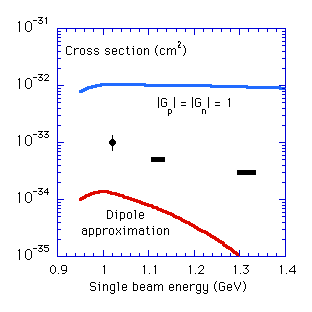 First measurement of electron-positron -> proton-antiproton
cross section
First measurement of electron-positron -> proton-antiproton
cross section
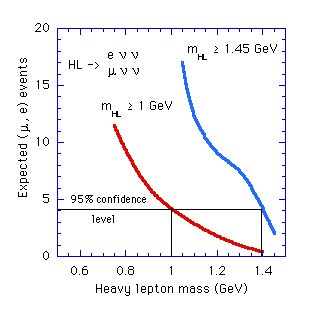 Limits to the new lepton mass from the BCF experiment. The low
energy of ADONE did not allow the discovery of the tau lepton.
Limits to the new lepton mass from the BCF experiment. The low
energy of ADONE did not allow the discovery of the tau lepton.
The experiments at ADONE produced immediately an unexpected and very
important result, which became one of the main justifications in favour
of the theories based on quarks as the point-like components of hadrons,
the strong-interacting particles. It was observed that electron-positron
collisions produced hadronic particles at a very large rate, even larger
than the rate of muon pairs, which should instead be larger if nucleons
and mesons were point-like themselves, not composed by other elementary
sub-particles.
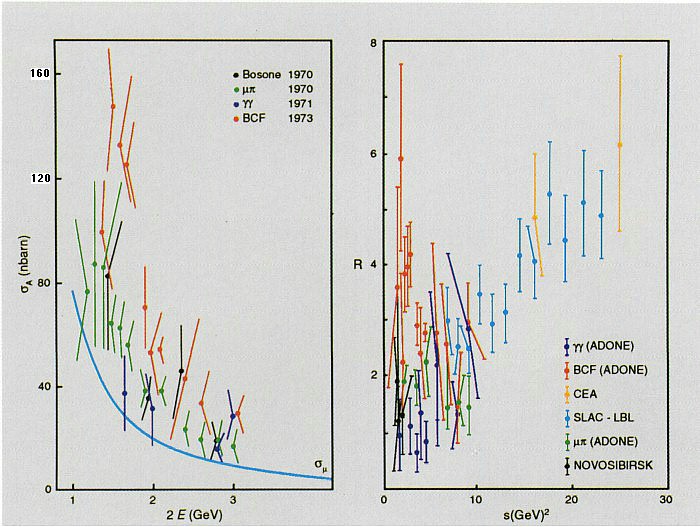 Multihadron production results obtained in Frascati from 1969
to 1974 (left plot): the blue line shows the muon pair production cross
section. The right plot shows world data on R (multihadron to muon production
rate) up to 1974.
Multihadron production results obtained in Frascati from 1969
to 1974 (left plot): the blue line shows the muon pair production cross
section. The right plot shows world data on R (multihadron to muon production
rate) up to 1974.
The first evidence of an anomalous multiple production came in 1970
from the measurements of the "boson" experiment. It was not demonstrated
that it was due to hadrons, but it was clear that in the electron-positron
collisions something happened at a rate and behaviour which could not be
explained by the known quantum electrodynamics. In fact, in a single electron-positron
interaction, three or more charged and neutral particles were produced
at a rate larger than any prediction. The proof that the outcoming particles
were hadrons was obtained from the observation of their interactions in
the absorbers, since muons undergo a very small amount of nuclear interactions.
The final demonstration came in 1971 from the BCF group.
The first interpretation of the experimental results from ADONE with
a three quark model showed up to be not sufficient. The ratio R between
the rate of electron-positron going into hadrons and muon pair production
yields a direct measurement of the number of quark-antiquark pairs of mass
smaller than that available from the electron-positron annihilation, and
coincides with the sum of the charges of any kind of existing quark. The
value of R, in the three quark model, could reach 2/3, while the observed
value was clearly larger, around 2.
This value is consistent with the assumption that the quarks have a
new degree of freedom, a peculiar characteristic called "colour", which
is the basis of the present theory of their interactions, quantum chromodynamics.
The experimental result from ADONE was an important contribution to the
development of this theory.
With the discovery of multiple production at ADONE, electron-positron
physics became immediately the field of maximum interest in sub-nuclear
physics, thus encouraging the construction of a large family of high energy
electron-positron colliders all over the world.
Other important results, at least partially unexpected, came from the
first generation of experiments at ADONE. First of all, the predictions
of quantum electrodynamics in purely electromagnetic reactions were confirmed
within the explored energy range, demonstrating in particular the point-like
nature of electrons and muons.
Photon-photon interactions were clearly identified for the first time
through the cinematic reconstruction of events with 4 electrons in the
final state. In addition to the three already discovered (rho, omega and
phi), the first evidence of the rho (1600) vector meson was found and the
first measurement of the production rate of barionic matter and antimatter
was performed. Finally, a lower limit to the mass of new leptons could
be fixed, having excluded their existence in the explored energy range
with a very high confidence level. The heavy lepton tau (1784 MeV) was
discovered at SPEAR
(Stanford) in 1975.
SECOND GENERATION EXPERIMENTS AT ADONE
-
 The MEA Experiment
The MEA Experiment
-
 The Gamma-Gamma 2 Detector
The Gamma-Gamma 2 Detector
-
 The Barion-Antibarion Detector
The Barion-Antibarion Detector
-
Click on icon to get the picture (~ 200 Kb)
The results of the experiments at ADONE stressed the limits of the first
generation detectors, designed under the assumption, immediately contradicted
by the observations, that only few particles could be found in the final
states of electron-positron annihilation. The great interest towards the
study of electron-positron collisions arisen from the first results required
improvements both in the storage ring operation and the development of
new and more complex detectors, taking into account the most recent technological
developments in the particle detector field.
In particular, the requirement of a complete analysis of the final states
particle properties asked for a detector placed in a magnetic field to
discriminate the charge and measure the particle momentum. In order to
fulfil this requirement, researchers from Frascati, Naples, Padua and Rome
realised MEA (Magnete Esperienze Adone), a detector made of large
gap chambers and spark chambers, placed inside a large solenoidal magnet.
The Gamma-Gamma 2 Experiment was the natural development of the
Gamma-Gamma Detector (scintillation counters, converters and spark chambers),
covering a larger solid angle with a better sampling of electromagnetic
and hadronic showers.
The Baryon-Antibaryon Experiment was designed to study proton-antiproton
and, more generally, any baryon-antibaryon pair, similar to protons, but
with a larger mass, looking mainly at the energy threshold of the reaction.
The detector consisted in large liquid scintillators, wire chambers with
magnetostrictive reading and flash tube chambers. The experiment was realised
by a collaboration between Frascati, Naples, Pisa and Istituto Superiore
di Sanita'.
In November 1974 the field of subnuclear physics was deeply upset by the discovery
of a new, completely unexpected particle, characterised by an extraordinary
stability for its large mass, ~3.1 GeV. The particle was discovered at the same
time at the electron-positron storage ring SPEAR
at Stanford (where it was called "psi") and at the proton synchrotron
of the Brookhaven National Laboratory,
near New York, where it was called J.
The energy in the center of mass needed to produce the new particle
was only ~0.1 GeV above the nominal operating energy of ADONE: this explains
why it was not discovered before at ADONE. However, it was decided to push
the performance of the machine beyond its standard parameters, in the energy
range indicated by the american laboratories. After three days the signal
of the new particle appeared in an extremely clear way, as a very high
cross section within a so small width, that it was completely hidden by
the intrinsic energy spread of the particles interacting in the collider.
The second generation detectors at ADONE had unique features to identify
some peculiar aspects of the new particle, and in this way they were able
to give significant contributions to the measurement of its properties.
In addition, it was decided to scan the whole energy range of ADONE in
small steps (1 MeV) to look for the existence of other narrow resonances
of lower energy.
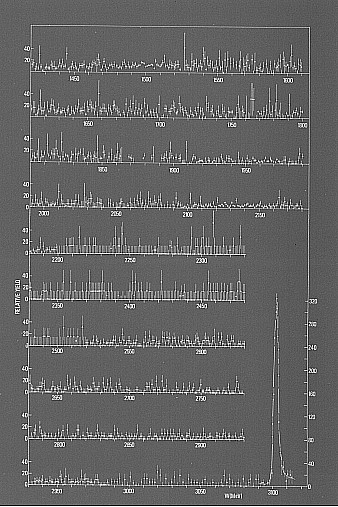 Results of the high resolution energy scanning at ADONE for
the search of fine structures produced in electron-positron annihilation.
The cross section exhibits small fluctuations before "exploding" at the
J/psi resonance (3.1 GeV)
Results of the high resolution energy scanning at ADONE for
the search of fine structures produced in electron-positron annihilation.
The cross section exhibits small fluctuations before "exploding" at the
J/psi resonance (3.1 GeV)
The importance of the J/psi discovery lies in the fact that it
is the proof of the existence, in addition to the already known three quarks,
of a new type of quark, currently called "charm", which represents a new
class of fundamental constituents of matter. Its existence was already
foreseen in 1970 by Sheldon Glashow, John Iliopulos and Luciano Maiani,
in order to include the behaviour of the quarks within a unified theory
of electromagnetic and weak forces, and explain in a very elegant way the
absence of some weak decays of strange particles.
ADONE AS A SOURCE OF SYNCHROTRON RADIATION
Synchrotron radiation, as it is called the electromagnetic radiation emitted
by electrons stored in a circular ring, is now one of the most helpful
tools for research in physics, chemistry, biology and advanced technological
applications.
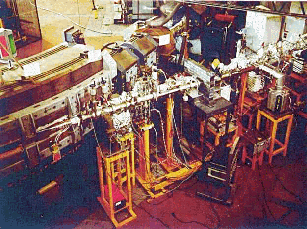 A synchrotron radiation beamline from a bending magnet of ADONE
A synchrotron radiation beamline from a bending magnet of ADONE
The synchrotron radiation has been used for the first time in the early
sixties at the Frascati Electron Synchrotron
for research in the field of solid state physics. After those first pioneering
experiments, in 1978, a systematic utilisation of the synchrotron radiation
from ADONE, emitted at high intensity and short pulses on a spectrum extending
from the ultraviolet to soft X-rays, was started.
The light was separated in several bands of well defined wavelength,
concentrated by means of mirror systems and directed towards the PULS
(Progetto Utilizzo Luce di Sincrotrone) laboratory, where it was used to
perform experiments in the fields of atomic and molecular spectroscopy,
materials structure, semiconductor properties, photochemistry and biophysics.
Synchrotron radiation in the hard X-rays energy range, above that produced
by the electrons in the ADONE bending magnets, has been obtained in Frascati
by inserting into a straight section of ADONE a special magnet, called
"wiggler", made of poles of alternating polarity, where the electrons are
forced to perform a sinusoidal type trajectory. In this way one can exploit
a maximum field larger than the bending magnets one and sum up the intensity
of the radiation from the peaks of the electron trajectory inside the wiggler.
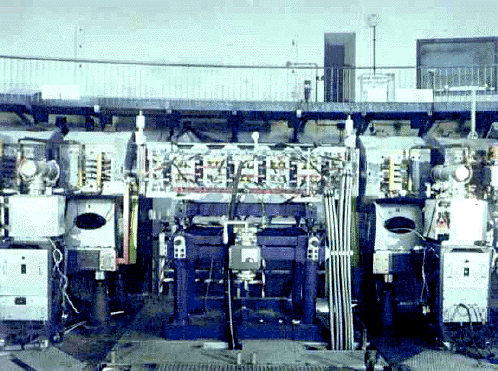 The wiggler magnet installed on ADONE for the production of
intense, variable energy X-ray beams
The wiggler magnet installed on ADONE for the production of
intense, variable energy X-ray beams
Because of the high "brilliance" of the machine (the number of photons
per second emitted by the beam per unit source surface and per unit solid
angle), it was possible to realise an intense source of X-rays with an
energy between 3 and 30 KeV, for a large research program in several research
and technology fields, called PWA (Progetto Wiggler Adone). The experimental
activity of PWA started in 1980 with a series of experiments of atomic
absorption spectroscopy in a wide energy spectrum and of atomic structure
analysis.
The X fluorescence induced by the synchrotron radiation allows the identification
of elements present inside a given specimen at a density of the order of
one part per million: this kind of analysis has been widely used in PWA
for industrial applications, medicine, environment control, study of artistic
pieces and dating. The X fluorescence technique enables also the simultaneous
analysis of different chemical elements in the specimen under observation.
Beams of high intensity and energy resolution in the X-ray bandwidth
enable advanced microscopy experiments and can be utilised for lithographic
engraving with a precision of the order of microns. In X-ray lithography
the photon beam can transfer a frame, even very complicated, from a master
mask to the surface to be engraved, reducing it to microscopic size. This
kind of technique has also been developed and used in PWA.
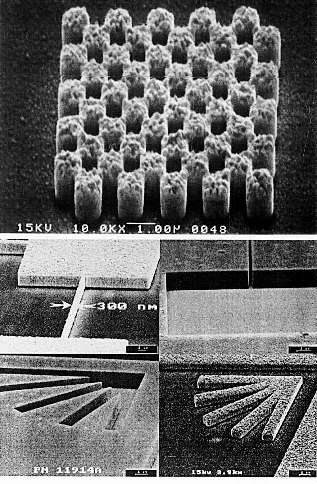 Sub-micron structures realised in the PWA laboratory by X-ray
lithography
Sub-micron structures realised in the PWA laboratory by X-ray
lithography
The Jet Target Facility
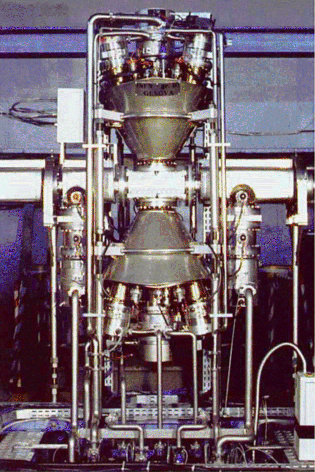 The Jet Target installed on ADONE for the production of a gamma-ray
beam to be utilised in nuclear physics experiments: the upper cone contains
the injection system of the argon jet, which crosses the electron beam
in the central interaction chamber and is recovered in the lower cone.
The Jet Target installed on ADONE for the production of a gamma-ray
beam to be utilised in nuclear physics experiments: the upper cone contains
the injection system of the argon jet, which crosses the electron beam
in the central interaction chamber and is recovered in the lower cone.
An electron accelerator can produce a photon beam by decelerating the
electrons by means of a target inside the ring. A recent technique, called
Jet Target, delivers photon beams of adjustable and well defined
energy without destroying the electron beam and with no harm to the ultravacuum
environment of the accelerator vacuum vessel.
The Jet Target installed on ADONE in 1990 provided collisions between
the stored electrons and a thin gas jet of Argon to generate the reaction
e + Ar -> e + Ar + gamma , where the electron loses energy emitting a photon.
The energy of the emitted photon can be measured accurately by precisely
detecting the energy lost by the electron (this technique is called "tagging").
With this facility monochromatic photon beams have been produced with
high intensity (up to 7x105 tagged photons per second) in the
energy range from 0.2 to 1.2 GeV, which have been exploited for a large
variety of measurements on photonuclear absorption on light and heavy nuclei
(up to U238) and on the production of neutral particles (gamma, neutral
pion) in the photon-nucleus interaction. These experiments yield information
on the influence of nuclear matter on the intrinsic properties of the nucleons
and on the hadronic nature of virtual photons.
Researchers from Frascati, Genoa and Istituto Superiore di Sanita' collaborated
in this research program.
The Ladon Facility
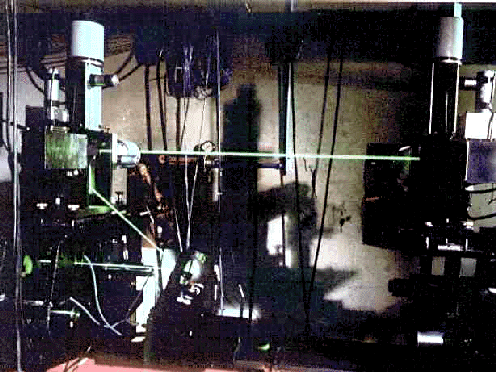 The Argon laser beam under test
The Argon laser beam under test
LADON, a facility providing a monochromatic polarised gamma-ray
beam, obtained by backward Compton scattering of laser light on the electrons
stored in ADONE, showed up to be a very efficient tool for experiments
in nuclear physics because of its unique characteristics:
-
high energy resolution
-
full or operator adjustable polarisation
-
very low background of different energy and polarisation photons
-
energy adjustable between 5 and 80 MeV
-
intensity fulfilling requirements of photonuclear reactions experiments
LADON has been utilised for the detailed study of photonuclear reaction
on light and heavy nuclei. In particular the asymmetry factor of deuterium
photodisintegration has been measured at several energies between 20 and
70 MeV, giving clear experimental indications for a correct theoretical
description.
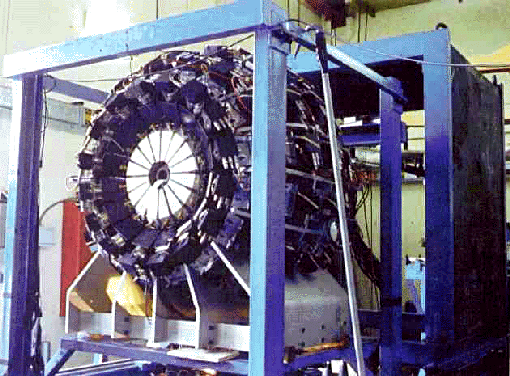 The LADON Crystal Ball
The LADON Crystal Ball
Moreover, precise measurements of total cross sections of two body photodisintegration
of deuterium and Helium4 clarified some unexplained problems and wrong
interpretations of experimental data about the reactions
gamma + d -> p + n
gamma + He4 -> tritium + p
gamma + He4 -> He3 + n
Another research line was the study of quasi-deuton reactions in intermediate
nuclei such as silicon, and photofission reactions in heavy nuclei.
The LADON group hosted researchers and technicians from Frascati, the
two Universities in Rome, Istituto Superiore di Sanita' and their associated
INFN sections. The experience gained at
ADONE is now being exploited at Brookhaven
and at ESRF in Grenoble, by performing experiments which extrapolate to
much larger energies (0.2÷ 2.0 GeV) the techniques developed in
Frascati.
Neutron-Antineutron Production at ADONE
-
 The Fenice
Detector
The Fenice
Detector
-
Click on icon to get the picture (~ 148 Kb)
In 1990, after several years dedicated to single beam operation for synchrotron
radiation and nuclear physics, two beam operation with electrons and positrons
was resumed to perform the last subnuclear physics experiment, FENICE,
whose data taking lasted until the final shutdown of ADONE in 1993. The
FENICE experiment's goal is to overcome a gap in our knowledge about the
internal structure of the neutron, by measuring its electromagnetic form
factor through the reaction electron + positron -> neutron + antineutron.
The results of such a measurement, never done before, together with
the existing data on the reaction electron + positron -> proton + antiproton
yield one of the essential experimental backgrounds for the most modern
theories based on the quark structure of the proton and the neutron.
 M.Preger , F.Murtas
20 MAR 1997
M.Preger , F.Murtas
20 MAR 1997












